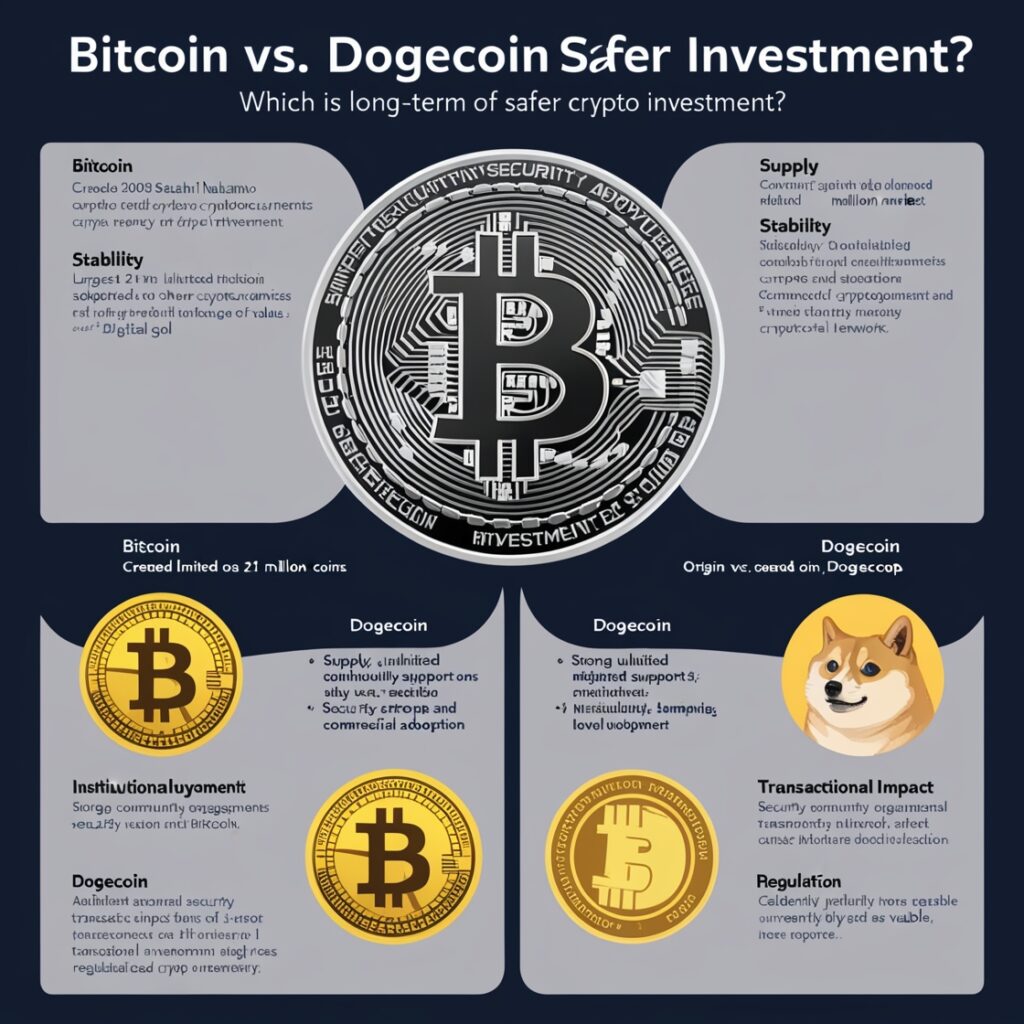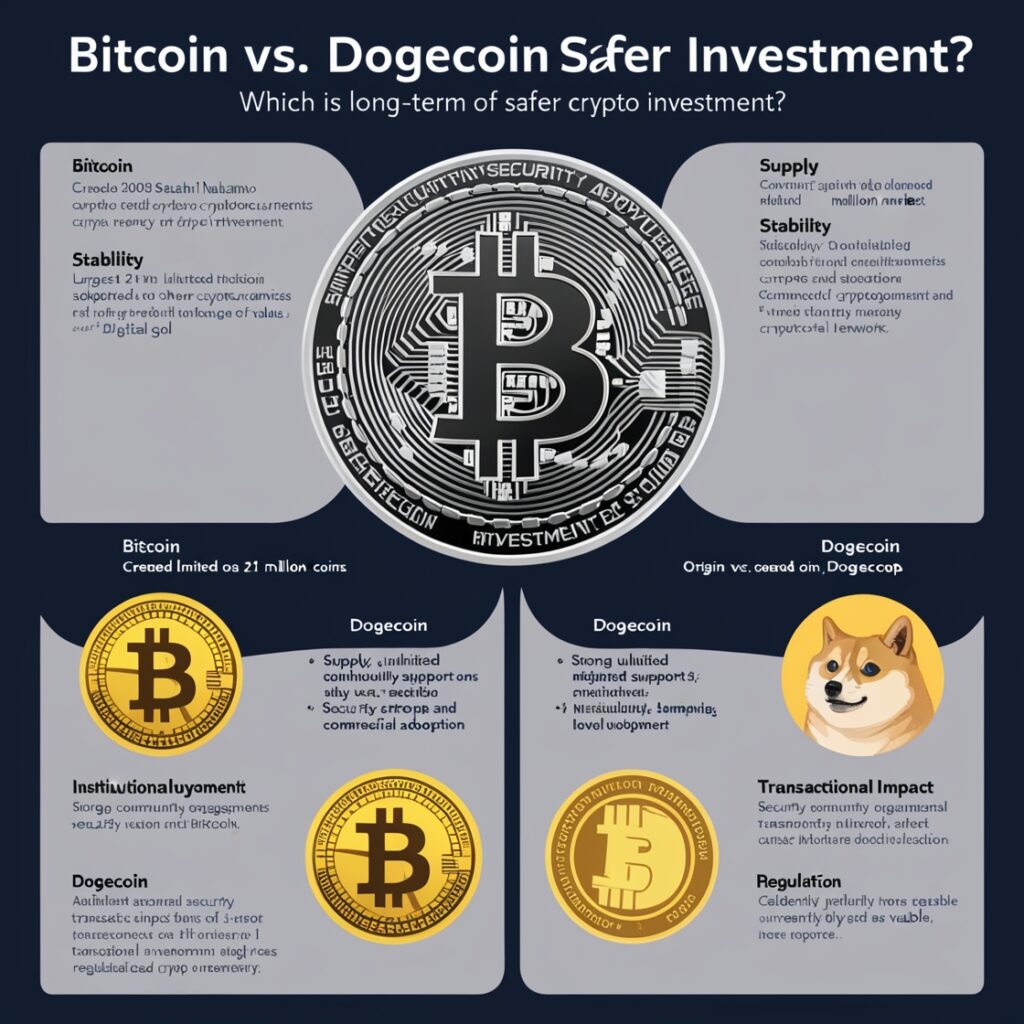In the ever-evolving world of cryptocurrency, investors constantly seek the safest and most profitable options. Two popular contenders that often come up in these discussions are Bitcoin and Dogecoin. While both have garnered significant attention in recent years, they differ greatly in their origins, purposes, and market behaviors. This article will delve deep into the characteristics of both cryptocurrencies to help you determine which might be a safer investment option.

Understanding Bitcoin
Bitcoin, the world’s first and most well-known cryptocurrency, was created in 2009 by an anonymous person or group using the pseudonym Satoshi Nakamoto. It was designed as a decentralized digital currency that operates on a peer-to-peer network without the need for intermediaries like banks or governments.
Key Features of Bitcoin
Limited Supply: One of Bitcoin’s most notable features is its capped supply of 21 million coins. This scarcity is often compared to precious metals like gold, earning Bitcoin the nickname “digital gold.”Decentralization: Bitcoin operates on a distributed ledger technology called blockchain, which ensures that no single entity controls the network.Security: The Bitcoin network is secured by complex cryptographic algorithms and a vast network of computers worldwide, making it extremely difficult to hack or manipulate.Store of Value: Many investors view Bitcoin as a store of value and a hedge against inflation, particularly during economic uncertainty.
Bitcoin’s Market Performance
Bitcoin has experienced significant price volatility since its inception, with dramatic ups and downs that have both rewarded and burned investors. However, its overall trajectory has been upward, with the cryptocurrency reaching all-time highs multiple times over the years.
Institutional Adoption: In recent years, Bitcoin has seen increasing adoption by institutional investors and major corporations, lending it more credibility as an investment asset.
Regulatory Scrutiny: As Bitcoin has grown in popularity and value, it has also attracted more regulatory attention, which can impact its price and accessibility.
Understanding Dogecoin
Dogecoin, created in 2013 by software engineers Billy Markus and Jackson Palmer, started as a joke based on the popular “Doge” meme featuring a Shiba Inu dog. Despite its humorous origins, Dogecoin has grown into a significant player in the cryptocurrency market.
Key Features of Dogecoin
Unlimited Supply: Unlike Bitcoin, Dogecoin has no cap on its total supply. New coins are mined continuously, which can lead to inflationary pressure.
Community-Driven: Dogecoin has a strong and active community that has driven its adoption and popularity, often rallying around charitable causes.
Lower Transaction Fees: Compared to Bitcoin, Dogecoin typically has lower transaction fees, making it more suitable for smaller, everyday transactions.
Celebrity Endorsements: Dogecoin has benefited from high-profile endorsements, most notably from Tesla CEO Elon Musk, which have contributed to its price surges.
Dogecoin’s Market Performance
Dogecoin’s price history has been characterized by extreme volatility, with periods of relative stability punctuated by dramatic price spikes often driven by social media hype and celebrity mentions.
Meme Coin Status: Its status as a “meme coin” has both helped and hindered Dogecoin, attracting attention but also raising questions about its long-term viability as a serious investment.
Rapid Price Movements: Dogecoin has seen some of the most rapid price increases in cryptocurrency history, but equally dramatic drops have often followed these.
Comparing Investment Safety
When considering the safety of investing in Bitcoin versus Dogecoin, several factors come into play:
Market Capitalization and Liquidity
Bitcoin: With a significantly larger market cap, Bitcoin offers greater liquidity and stability compared to most other cryptocurrencies.Dogecoin: While its market cap has grown substantially, it remains much smaller than Bitcoin’s, potentially leading to higher volatility and liquidity risks.
Technology and Development
Bitcoin: Bitcoin has a robust development community and has seen continuous improvements to its underlying technology, enhancing its security and functionality.Dogecoin: While Dogecoin has an active community, its technological development has been less consistent, which could impact its long-term viability.
Adoption and Use Cases
Bitcoin: Widely recognized as a store of value and increasingly accepted as a payment method by businesses worldwide.Dogecoin: Primarily used for tipping and small transactions within its community, with limited adoption in mainstream commerce.
Regulatory Landscape
Bitcoin: As the most established cryptocurrency, Bitcoin has attracted significant regulatory attention, which can be both a benefit (in terms of legitimacy) and a risk (potential for restrictive regulations).
Dogecoin: Due to its smaller market presence, Dogecoin is less scrutinized by regulators, but this could change rapidly if its popularity continues to grow.
Price Stability
Bitcoin: While still volatile compared to traditional assets, Bitcoin has shown relatively more stability as it has matured.Dogecoin: Extremely volatile, with price movements often driven by social media trends and celebrity mentions rather than fundamental factors.
Investment Strategies and Considerations
When deciding between Bitcoin and Dogecoin as an investment, consider the following strategies:
Diversification
Investing in Bitcoin, Dogecoin, and other cryptocurrencies and traditional assets can help spread risk and potentially capture gains from different market segments.
Long-Term vs. Short-Term Outlook
Bitcoin may be more suitable for long-term, “buy and hold” strategies due to its established position and limited supply.
Dogecoin might appeal more to short-term traders looking to capitalize on rapid price movements, but this comes with higher risk.
Risk Tolerance
Assess your personal risk tolerance. Bitcoin, while still risky compared to traditional investments, generally presents a lower risk profile than Dogecoin in the cryptocurrency space.
Research and Due Diligence
Regardless of which cryptocurrency you choose, thorough research is essential. Stay informed about technological developments, regulatory changes, and market trends affecting your chosen investment.
The Role of Market Sentiment
Both Bitcoin and Dogecoin are significantly influenced by market sentiment, but in different ways:
Bitcoin sentiment often reflects broader economic trends and institutional interest in cryptocurrency.
Dogecoin sentiment is more closely tied to social media trends and the actions of its community and high-profile supporters. Understanding these sentiment drivers can help investors anticipate potential price movements and make more informed decisions.
Environmental Considerations
The environmental impact of cryptocurrency mining has become an increasingly important factor for many investors:
Bitcoin mining is energy-intensive, leading to concerns about its carbon footprint.
Dogecoin, while also using a proof-of-work system, is generally considered less energy-intensive than Bitcoin. Investors concerned about environmental issues may need to weigh these factors in their decision-making process.

Conclusion: Making Your Choice
Whether Bitcoin or Dogecoin is a safer investment depends on your financial goals, risk tolerance, and investment strategy. With its larger market cap, more established presence, and growing institutional adoption, Bitcoin generally presents a lower risk profile within the volatile cryptocurrency market. Its limited supply and status as “digital gold” make it an attractive option for those looking for a potential store of value and hedge against inflation.
Conversely, Dogecoin offers the potential for rapid gains but comes with significantly higher risk. Its unlimited supply and reliance on community sentiment make it a more speculative investment. While it has shown impressive price movements, the lack of fundamental value drivers makes its long-term prospects more uncertain.
For risk-averse investors looking to be exposed to the cryptocurrency market, Bitcoin may be the safer choice. Its relative stability (within the crypto world) and growing mainstream acceptance provide a stronger foundation for long-term investment.
However, for those willing to take on higher risk in pursuit of potentially greater short-term rewards, Dogecoin might be an option to consider, albeit with caution. Its community-driven nature and lower price point can make it an attractive entry point for new crypto investors, but the potential for significant losses should not be underestimated.
Ultimately, the safest approach may be viewing Bitcoin and Dogecoin as part of a diversified cryptocurrency portfolio rather than choosing between them. By allocating investments across different cryptocurrencies and traditional assets, investors can benefit from the crypto market’s growth while mitigating some of the risks associated with individual coins.
As with any investment, particularly in the highly volatile world of cryptocurrencies, it’s crucial never to invest more than you can afford to lose and stay informed about digital assets’ rapidly changing landscape. Whether you choose Bitcoin, Dogecoin, or a mix of cryptocurrencies, approaching your investment with a clear strategy, thorough research, and realistic expectations will be key to navigating this exciting but unpredictable market.
